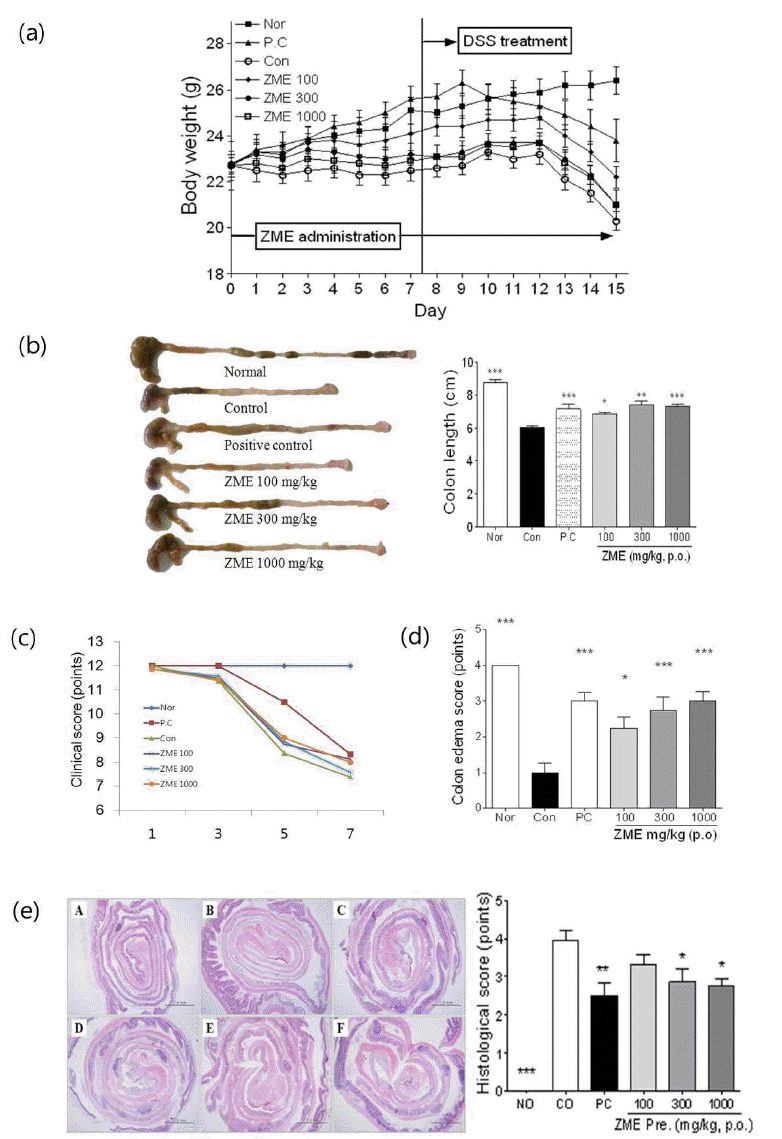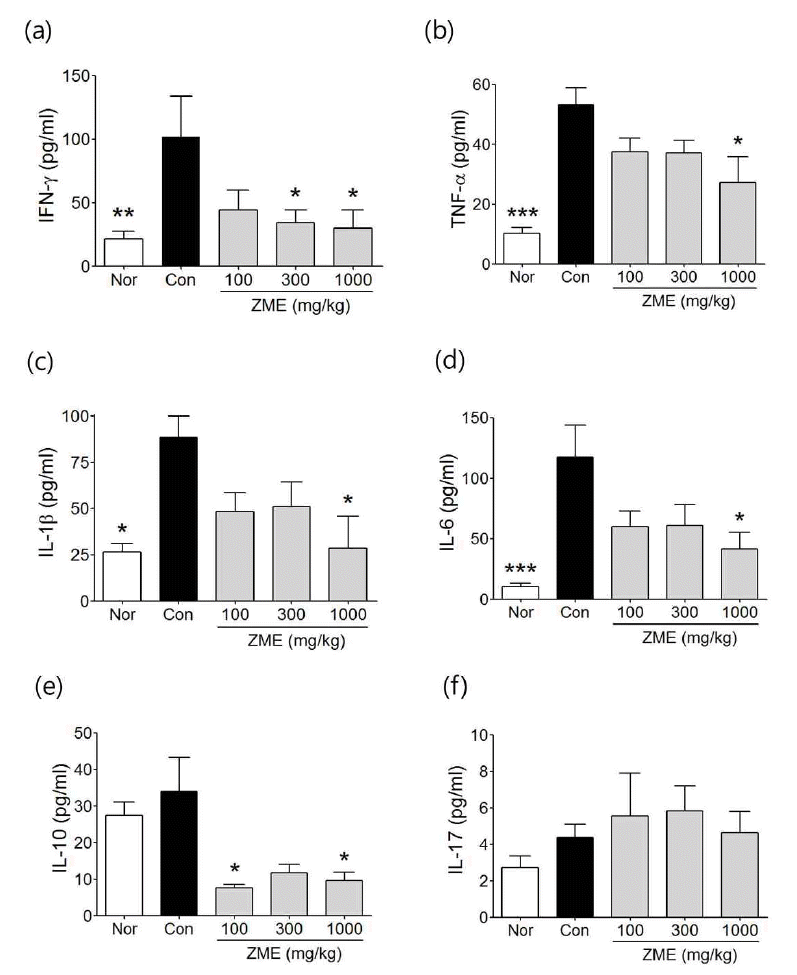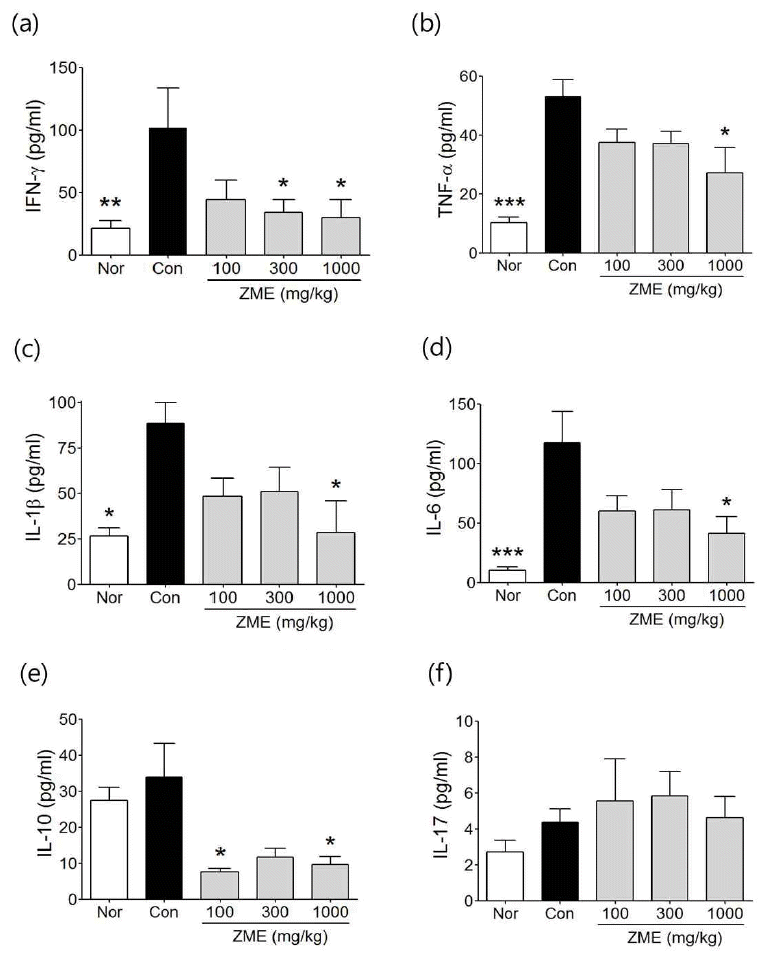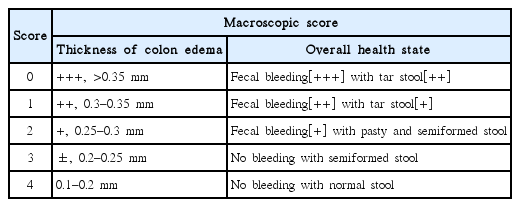References
1. Yang SK. Current Status and Clinical Characteristics of Inflammatory Bowel Disease in Korea. Korean J Gastroenterol 2002;40:1–14.
2. Department of Internal Medicine, Medical School, Seoul National University. Guideline of Internal Medicine 1st edth ed. Seoul: Korea Medicine Publication; 2002. p. 51–3.
3. Kim JY. Gastrointestinal Disorders 1st edth ed. Seoul: Iljogak; 2000. p. 258–76.
4. Park JW, Bu Y, Bae J, Lee B, Ko S, Kim J, et al. Protective effects of Ulmus macrocarpa on experimental colitis mice models. Orient Pharm Exp Med 2011;11:107–12.
5. Seo GS, Choi SC. Special Review-Ulcerative colitis: Pathophysiology of ulcerative colitis – Relationship with genetics and immunity-. Korean J Med 2009;76(7):643–8.
6. Kim TH, Kim BG, Sin HD, Kim JW, Kim CG, Kim JS, et al. Alimentary Tract: Tumor Necrosis Factor-a and Interleukin-10 Gen Polymorphisms in Korean Patients with Inflammatory Bowel Disease. Korean J Gastroenterol 2003;42:377–86.
7. Korean Association of Gastroenterology. Inflammatory Bowel Diseases 1st edth ed. Seoul: Gunja Publication; 1999. p. 61.
8. Siegal CA. Review article: explaining risks of inflammatory bowel disease therapy to patients. Aliment Pharmacol Ther 2011;33:23–32.
9. Lee JY, Kang HS, Park BE, Moon HJ, Sim SS, Kim CJ. Inhibitory effects of Geijigajakyak-Tang on trinitrobenzene sulfonic acid-induced colitis. J Ethnopharmacol 2009;126:244–51.
10. Kim SY, Ryu B, Park JW. Effects of Samiunkyungtang on inflammation and fecal enzymes in ulcerative colitis animal model. J Korean Med 2008;29(3):56–62.
11. Ryu B, Ro W, Park JW, Bu Y, Lee BJ, Lim S, et al. Bojanggunbi-tang, a traditional Korean herbal prescription, ameliorates colonic inflammation induced by dextran sulfate sodium and 2,4,6-trinitrobenzene sulfonic acid in mice. J Ethnopharmacol 2011;135(2):582–5.
12. Song YG, Ryu B, Yoon SW. The Effects of Soyumjungjang-tang on DSS-Induced Ulcerative Colitis in Mouse. Korean J Orient Int Med 2008;29(2):385–400.
13. Hong SS, Ryu B, Yoon SW, Kim JS. The effect of Sagunja-tang on TNBS-induced Inflammatory Bowel Disease in Mouse. Korean J Orient Int Med 2010;31(4):731–51.
14. Lee SW, Ryu B, Park JW. Effects of Sagassum pallidum on 2,4,6-Trinitrobenzene Sulfonic Acid-Induced Colitis in Mice. Korean J Orient Int Med 2010;31(2):224–41.
15. Chung HL, Yue GGL, To KF, Su YL, Huang Y, Ko WH. Effect of Scutellariae Radix extract on experimental dextran-sulfate sodium-induced colitis in rats. World J Gastroenterol 2007;13(42):5605–11.
16. Choi HG, Lee JH, Park HH, Sayeghet FAQ. Antioxidant and Antimicrobial Activity of Zostera marina L. Extract. Algae 2009;24(3):179–84.
17. Harrison PG. Control of microbial growth and of amphipod grazing by water-soluble compounds from leaves of Zostera marina. Mar Biol 1982;67:225–30.
18. Harrison PG, Chan AT. Inhibition of the growth of micro-algae and bacteria by extracts of eelgrass(Zostera marina) leaves. Mar Biol 1980;61:21–6.
19. Khasina EI, Kolenchenko EA, Sgrebneva MN, Kovalev VV, Khotimchenko YS. Antioxidant activities of a low etherfied pectin from the seagrass Zostera marina. Russian J Mar Biol 2003;29:259–61.
20. Kolenchenko EA, Sonia LN, Khotimchenko YS. Comparative in vitro assessment of antioxidant activities of a low etherfied pectin from the eelgrass Zostera marina. and antioxidantive medicines. Russian J Mar Biol 2005;31:331–4.
21. Khasina EI, Tiupeleev PA, Sgrebneva MN. Gastroprotective effect of zosterin, a pectin from seagrass Zostera Marina L. Orient Pharm Exp Med 2004;4(4):253–60.
22. Lee IA, Bae EA, Hyun YJ, Kim DH. Dextran sulfate sodium and 2,4,6-trinitrobenzene sulfonic acid induce lipid peroxidation by the proliferation of intestinal gram-negative bacteria in mice. J Inflamm (Lond) 2010;7:7.
23. Kitajima S, Takoma S, Morimoto M. Histological analysis of murine colitis induced by dextran sulfate sodium of different molecular weights. Exp Animal 2000;49:9–15.
24. Song MY, Park SY, Kim JH, Ahn SH, Kim KS, Sohn IC. Effects of Moxi-tar Herbal Acupuncture of LI11 on inflammatory bowel disease induced by TNBS in mice. Korean J Acupunct 2008;25(3):147–66.
25. Baek DB, Kwon OS, Choi WJ, Kim JH, Jeon HY, Kim KS, et al. Moxi-tar Herbal Acupuncture of BL25 Acupoint Ameliorates TNBS-Induced Colitis in Mice. Korean J Acupunct 2007;24(3):149–64.
26. Kim YT, Ahn SH, Kim JH, Sohn IC. Effects of Moxi-tar Herbal Acupuncture at Cheonchu (ST25) on Crohn’s Disease Induced by TNBS in Mices. Korean J Acupunct 2008;25(2):159–77.
27. Kim SH, Kim HJ, Kim JE, Lee SH, Hong SH, Kim WI. Clinical Case of Symptoms Remaining after Western Medical Therapy in Ulcerative Colitis, with Herbal Medicine Dansamboheol-tang gagam, Acupuncture, and Moxibustion Treatment. Korean J Orient Int Med 2007;28(4):911–8.
28. Hwang JW, Choi HJ, Baik YS, Jeong SH, Shin GC, Lee WC. A Case of Pyungwijiyutang-gamibang Diagnosed as Constipation due to Stagnation of Eum with Ulcerative Colitis. Korean J Oriental Int Med 2007;28(4):972–7.
29. Kim CM, Shin MK, Ahn DG, Lee KS. The Great Dictionary of Chinese Herbs (Korean version) 1st edth ed. Seoul: Jungdam Publication; 1998. p. 6036–7.
30. Kirsner JB. Experimental colitis with particular reference to hypersensitivity reactions in the colon. Gastroenterology 1961;40:317–22.
31. Okasu I, Hatakeyama S, Yamada M, Ohkusa T, Inagaki Y, Nakaya R. A novel method in the induction of reliable experimental acute and chronic ulcerative colitis in mice. Gastroenterology 1990;98:694–702.
32. MacPherson BR, Pfeiffer CJ. Experimental production of diffuse colitis in rat. Digestion 1978;17:135–50.
33. Morris GP, Beck PL, Herridge MS, Depew WT, Szewczuk MR, Wallace JL. Hapten-induced model of chronic inflammation and ulceration in the rat colon. Gastroenterology 1989;96:795–803.
34. Strober W, Fuss IJ, Blumberg RS. The immunology of mucosal models of inflammation. Annu Rev Immunol 2002;20:495–549.
35. Egger B, Bajaj-Elliott M, MacDonald TT, Inglin R, Eysselein VE, Buchler MW. Characterisation of acute murine dextran sodium sulphate colitis: cytokine profile and dose dependency. Digestion 2000;62:240–8.
36. Ohkusa T. Production of experimental ulcerative colitis in hamsters by dextran sulfate sodium and change in intestinal microflora. Jpn J Gastroenterol 1985;82:1327–36.
37. Kitajima S, Takoma S, Morimoto M. Chages in colonic mucosal permeability mouse colitis induced with dextran sulfate sodium. Exp Animal 1999;48:137–43.
38. Kim SJ, Choi DH, Chung YT. Gliotoxin protects against TNBS-induced colitis. via down-regulation of NF-kB activation. Kor J Anat 2004;37(3):309–15.
39. Johswich K, Martin M, Bleich A, Kracht M, Dittrich-Breiholz O, Gessner JE, et al. Role of the C5a receptor (C5aR) in acute and chronic dextran sulfate-induced models of inflammatory bowel disease. Inflamm Bowel Dis 2009;15:1812–23.
40. Ko E, Kim JG, Kim JR, Kim HJ, Hong SJ, Park JS, et al. Pathophysiology 1st edth ed. Seoul: Korea Medicine Publication; 2006. p. 42–3.
41. O’Shea JJ, Murray PJ. Cytokine signaling modules in inflammatory responses. Immunity 2008;28:477–87.
42. Pizarro TT, Cominelli F. Cytokine therapy for Crohn’s disease: advances in translational research. Annu Rev Med 2007;58:433–44.
43. Dionne S, Hiscott J, D’Agata I, Duhaime A, Seidman EG. Quantitative PCR analysis of TNF-alpha and IL-1 beta mRNA levels in pediatric IBD mucosal biopsies. Dig Dis Sci 1997;42:1557–66.
44. Targan SR, Hanauer SB, Van Deventer SJ, Mayer L, Present DH, Braakman T, et al. A short-term study of chimeric monoclonal antibody cA2 to tumor necrosis factor α for Crohn’s disease. N Engl J Med 1997;337:1029–35.
45. Kwon HH, Kim EJ, Kim IT, Park KH, Yang MG, Eum YB, et al. Clinical Immunology 1st edth ed. Seoul: Korean Medicine Publication; 2010. p. 158–70.
46. Barnes PJ, Karin M. Nuclear factor-KB-a pivotal transcription factor in chronic inflammatory disease. N Engl J Med 1997;336:1066–71.
47. Fedorak RN, Gangl A, Elson CO, Rutgeerts P, Schreiber S, Wild G, et al. Recombinant human interleukin 10 in the treatment of patients with mild to moderately active Crohn’s disease. Gastroenterology 2000;119:1473–82.
48. Schreiber S, Fedorak RN, Nielsen OH, Wild G, Williams CN, Nikolaus S, et al. Safety and efficacy of recombinant human interleukin-10 in chronic active Crohn’s disease. Gastroenterology 2000;119:1461–72.
49. Fujino S, Andoh A, Bamba S, Ogawa A, Hata K, Araki Y, et al. Increased expression of interleukin 17 in inflammatory bowel disease. Gut 2003;52:65–70.




